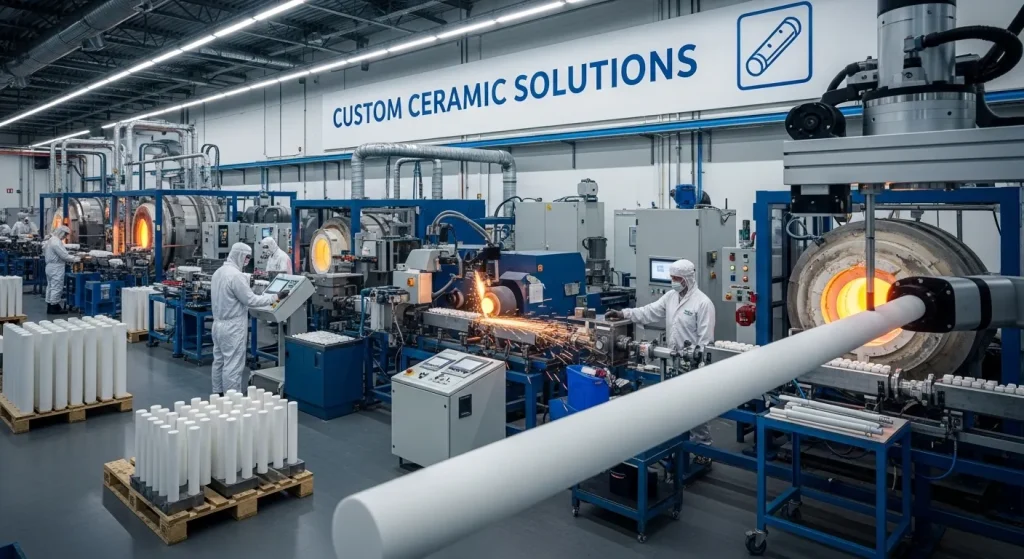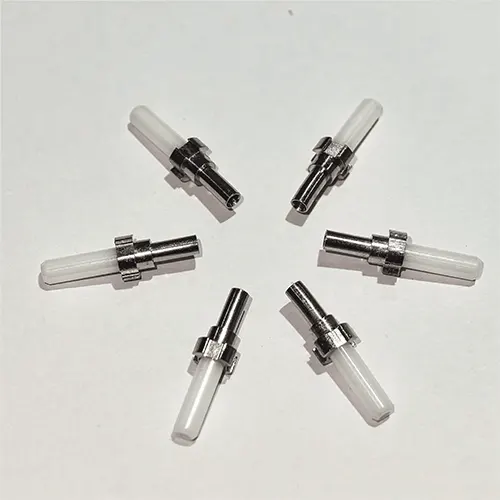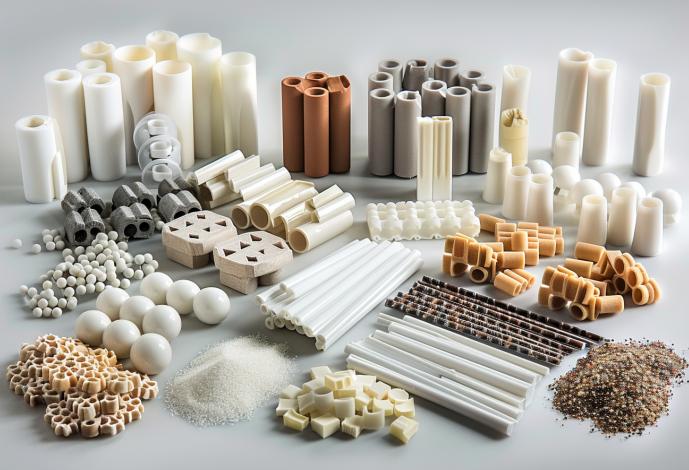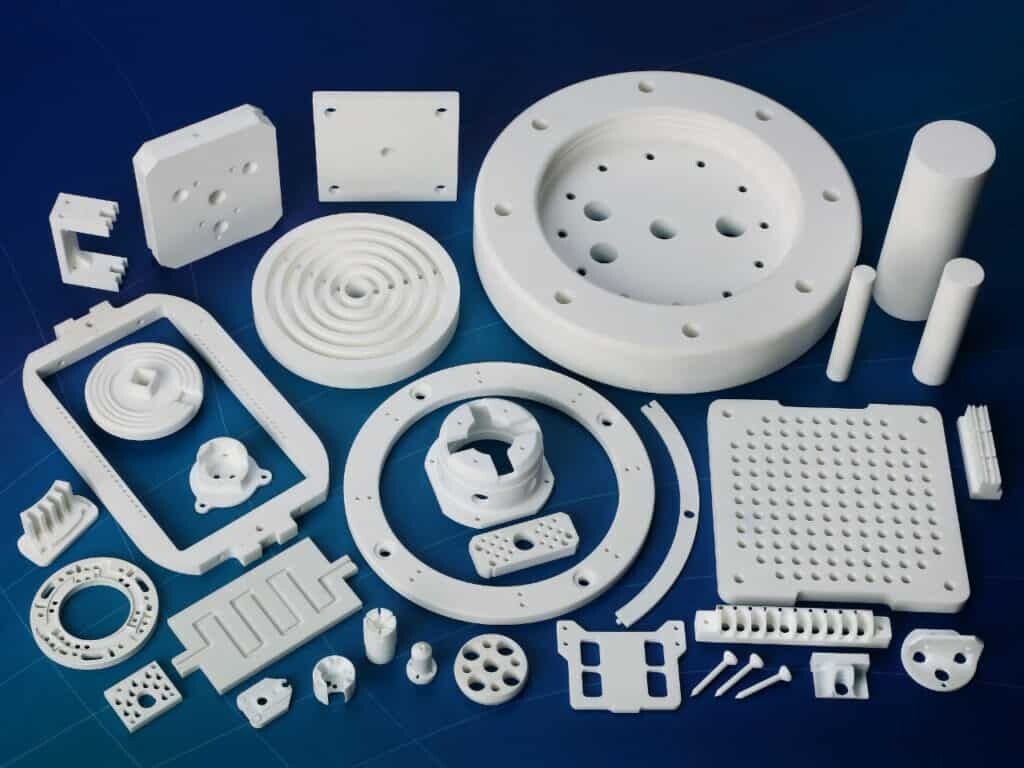Custom Ceramic Rods Manufacturer: A Complete Sourcing Guide
Finding a custom ceramic rods manufacturer is the critical step when a standard, off-the-shelf part simply will not work. Your application may involve extreme temperatures, unique physical dimensions, or a need for features like threads, holes, or specific surface finishes. A standard rod is a commodity. A custom rod is an engineered solution.

This guide is for the engineers, designers, and procurement managers who need to solve a problem that metal or plastic cannot. We will explore the design process from start to finish. We will cover the critical material choices you must make. Most importantly, we will provide a clear framework for how to find and vet a manufacturing partner who can turn your complex drawing into a precise, physical component.
What Is a "Custom Ceramic Rod"?
A custom ceramic rod is any ceramic rod that is not a standard, in-stock item. It is a component manufactured to your exact technical specifications. This means you, the customer, define every aspect of the part.
What makes a ceramic rod "custom"?
A ceramic rod is "custom" when it is manufactured to a unique drawing. This includes non-standard lengths and diameters, specific material compositions (like 99.8% Alumina), and special machined features. These features can include threads, grooves, flats, tapers, or internal and external holes.
While a standard rod is simply a straight cylinder, a custom rod can be a complex shaft, a threaded post, a locating pin, or a flanged axle.
When Do You Need a Custom Rod?
You need a custom part when your application demands it.
- Unique Fit: The rod must mate with another existing component, requiring a non-standard diameter or a specific feature like a flange or step.
- Prototyping: You are in an R&D phase. You need to test a new design and require a small batch of parts with unique geometry.
- Specific Function: The rod needs to do something. It may need a groove for an O-ring, a flat for a wrench, or a cross-hole for a pin.
- Extreme Environment: You need a specific material composition. For example, a standard 95% Alumina rod may not be pure enough for your semiconductor vacuum chamber, so you must custom-order a 99.9% Alumina rod.
The Critical First Step: How to Design Your Custom Rod
You cannot simply ask a manufacturer for "a custom rod." You must provide a clear and detailed technical drawing. This drawing is the single most important document in the entire process. It is the language your manufacturer speaks.
Your drawing (usually a PDF or CAD file) must include these four things.
1. All Critical Dimensions
This includes the basics:
- Outer Diameter (OD)
- Inner Diameter (ID) (if it is a tube)
- Overall Length
- Locations of all features (e.g., the position of a hole from the end of the rod).
2. Tolerances for Every Dimension
This is the most important part of a custom drawing. A tolerance is the "acceptable range" for a dimension. For example, a length of 100mm ±0.1mm is a very different part from a length of 100mm ±1.0mm.
- Be realistic. The tighter the tolerance, the more expensive the part.
- Do not specify a high-precision tolerance of $\pm 0.01\text{ mm}$ on a feature that does not need it. A good manufacturer will help you with this.
3. Required Material
You must specify the material. "Ceramic" is not enough. You must be specific.
- Good: "Alumina (99.5% Purity)"
- Better: "Yttria-Stabilized Zirconia (Y-TZP)"
- Bad: "A strong white ceramic"
4. Surface Finish (Ra)
This specifies the smoothness of the rod's surface. A rod straight from the furnace ("as-fired") is rough. A "ground" rod is smooth. A "lapped" or "polished" rod is mirror-smooth. Specifying a smoother finish adds cost.
What Custom Features Can Be Machined?
The main reason to work with a custom ceramic rods manufacturer is to add features. Advanced ceramics are incredibly hard, so machining them requires special tools and expertise.
Can ceramic rods be threaded or drilled?
Yes. A specialized manufacturer can add many complex features to a ceramic rod. This includes drilling cross-holes or axial holes, grinding internal or external threads, and cutting grooves, flats, and steps. This machining is done with diamond tools after the ceramic is fired, or by "green machining" before it is fired.
Here are the most common custom features:
- Threads (Internal or External): Used for assembling parts, like a ceramic bolt or a threaded standoff.
- Holes (Axial or Cross-Drilled): For mounting, inserting pins, or providing a path for wires or sensors.
- Grooves: Most often used to hold an O-ring for sealing.
- Flats: Milled onto the side of a rod so it can be held with a wrench or to prevent it from rotating in an assembly.
- Steps (Multi-Diameter): A single rod can be ground to have multiple different outer diameters along its length, like a custom shaft.
- Tapers: The rod can be ground to a cone shape or a pointed tip, often used for nozzles or locators.
- Flanges: A "lip" or "rim" can be formed at the end of the rod for mounting.
The Manufacturing Process: How Your Custom Part Is Made
Understanding the manufacturing process helps you understand the cost and lead time. There are two primary ways to make a custom part: "green machining" or "fired machining."
The Core Choice: Green Machining vs. Fired Machining
This is the most important concept in custom ceramic manufacturing.
What is "green machining" for ceramics?
Green machining is the process of cutting features into a ceramic part before it is fired (sintered). The part is in its "green state," which is a soft, chalk-like block. This process is much faster and cheaper than grinding the hard ceramic. However, it is less precise because the part will shrink 15-25% during firing.
Green Machining:
- A manufacturer starts with a large, unfired block of ceramic material (a "green blank").
- They use standard CNC milling machines to cut your custom shape, including holes, threads, and steps.
- The part is then fired in the kiln.
- Pro: Much faster and significantly cheaper.
- Con: Less precise. The part shrinks during firing, so holding tight tolerances is difficult. It is best for complex shapes where precision is secondary.
Fired Machining (Diamond Grinding):
- The manufacturer starts with a basic, standard rod that has already been fired.
- They use specialized CNC grinding machines with diamond-coated tools.
- These diamond tools slowly and precisely grind away the hard ceramic to create your features.
- Pro: Extremely high precision. Tolerances can be held to the micron level.
- Con: Very slow and very expensive. Diamond tooling is costly, and the process takes a long time.
A good manufacturer will look at your drawing and help you decide which process is best for your design and budget.
The Full Manufacturing Path (Fired Machining)
For most high-precision custom rods, the process looks like this:
- Forming the Blank: A standard rod is created first. Ceramic powder (like Alumina) is mixed with a binder. It is then extruded into a long, "green" rod.
- Sintering (Firing): The green rod is fired in a high-temperature kiln (often 1600°C+). The binder burns off, and the ceramic particles fuse. The rod shrinks and becomes incredibly hard.
- Centerless Grinding: The hard, sintered rod is now a "blank." It is run through a centerless grinder to give it a precise, smooth outer diameter.
- Custom CNC Diamond Grinding: This is the "custom" step. The blank is moved to a CNC grinding machine. Diamond tools are used to cut your threads, drill your holes, and grind your grooves. This is a slow, high-skill, expensive process.
- Quality Control: The final part is taken to a QC lab and measured on a CMM (Coordinate-Measuring Machine) or with laser micrometers to ensure every feature matches your drawing.
Choosing the Right Material for Your Custom Application
The material you choose dictates the performance of your part. A custom ceramic rods manufacturer can source and machine many materials, but the "Big Three" cover 95% of applications.
What is the best material for a custom ceramic rod?
The best material depends on your primary challenge. For high temperatures or electrical insulation, choose Alumina. For high strength, impact resistance, and toughness, choose Zirconia (often called "ceramic steel"). For extreme abrasion and wear resistance, choose Silicon Carbide.
1. Alumina (Aluminum Oxide, Al2O3)
This is the workhorse. It is the most common and cost-effective advanced ceramic.
- Best For:
- High-temperature supports (furnace parts)
- Electrical insulators
- General wear-resistance
- Grades: You can custom-order different purities. 95% is a common standard. 99.5% or 99.8% are used for higher purity, heat, or wear applications.
2. Zirconia (Zirconium Oxide, ZrO2)
This is the "ceramic steel." It is the toughest of all monolithic ceramics.
- Best For:
- High-impact or high-vibration uses (welding pins)
- High-strength applications (pump shafts, plungers)
- Medical or food-contact parts (biocompatible)
- Note: Zirconia solves the "brittleness" problem. If your main worry is that a ceramic part will chip or crack, Zirconia is your solution.
3. Silicon Carbide (SiC)
This is the extreme-duty material. It is one of the hardest substances on earth.
- Best For:
- Extreme abrasion (sandblasting nozzles)
- High-performance mechanical seals and bearings
- Chemical processing
- Note: Silicon Carbide is a semiconductor, so it is not an electrical insulator.
How to Find and Vet a Custom Ceramic Rods Manufacturer
This is the most important part of your journey. You are not just buying a part; you are hiring a high-skill machine shop. You must separate the true manufacturers from the simple distributors.
The Big Problem: Manufacturer vs. Distributor
- A Distributor/Trader: Buys and sells standard rods. They cannot make your custom part. When you send them a drawing, they simply forward it to a real manufacturer and add their markup. They are a middle-man.
- A Manufacturer: Has the factory. They have the kilns, the grinders, and the engineers. They will make your part themselves.
You must work directly with a manufacturer.
Your 5-Step Vetting Checklist
Use these questions to identify a true manufacturing partner.
1. "Can you show me your in-house grinding capabilities?"
- This is the #1 question. A custom manufacturer must have their own diamond grinding equipment. Ask for pictures or a video tour of their CNC grinders and centerless grinders. If they cannot provide this, they are not a manufacturer.
2. "Can you do a DFM review of my drawing?"
- DFM stands for "Design for Manufacturability." A true partner will act as a consultant. They will look at your drawing and say, "We can make this, but if you change this tolerance from 0.01mm to 0.05mm, you will save 40% on the cost. Is that feature critical?" This feedback is priceless.
3. "What are your MOQs and prototyping costs?"
- "MOQ" is Minimum Order Quantity. Setting up a CNC grinding machine for a custom job takes time. Most manufacturers will have a high MOQ (e.g., 100+ pieces) for a production run.
- Ask: "Do you offer a paid prototyping service?" A good manufacturer will be willing to make 5-10 pieces for a higher "per-piece" price so you can test the design.
4. "Which machining process will you use: green or fired?"
- This is an expert question. It shows you understand the process. Their answer will tell you a lot. They should be able to explain why they chose one method over the other for your specific part (e.g., "For your threads, we must use diamond grinding, but for the cross-hole, we can use green machining.").
5. "What QC reports will I receive with my order?"
- How will you know the part is correct? Ask them how they measure it.
- A professional manufacturer will have a QC lab with a CMM (Coordinate-Measuring Machine), laser micrometers, and a profilometer (for surface roughness).
- Ask for a "First Article Inspection Report" (FAIR). This is a document where they measure every single dimension on your drawing for the first part and confirm it is within tolerance.
Sourcing Custom Ceramic Rods: A Global Perspective
The market for custom ceramic machining is global. Different regions have different strengths. Your choice will depend on your needs for speed, cost, and compliance.
Ceramic Rods Manufacturer USA
- Specialty: High-spec, low-volume, and R&D. The ceramic rods USA market is a world leader in parts for aerospace, defense (ITAR compliant), and medical (FDA traceability).
- Best For: Rapid prototyping, projects where absolute traceability is required, and defense applications.
Ceramic Rods Manufacturer Europe
- Specialty: Extreme precision and advanced engineering. The ceramic rods Europe market, especially in Germany, is renowned for its technical mastery, complex CNC machining, and industrial automation components.
- Best For: Ultra-high-precision parts, complex 5-axis machining, and research-grade components.
Sourcing from Asia (China, India, etc.)
- Specialty: Scale and cost-effectiveness. Manufacturers in Asia are highly capable of complex custom work at a price point that is very competitive.
- Best For: Production runs (after a design is finalized), cost-driven projects, and high-volume orders.
- Note: The industrial markets in places like ceramic rods Indonesia are also growing, often serving local heavy industries (like palm oil or chemical processing) that need tough, custom parts.
The Future of Custom Ceramics: 3D Printing and New Materials
The "custom" world is evolving. Two technologies are changing what is possible.
- Additive Manufacturing (3D Printing): It is now possible to 3D print ceramics. A part is printed from a slurry of ceramic powder and binder, then sintered just like a molded part. This allows for incredibly complex shapes (like internal cooling channels) that are impossible to machine.
- Advanced Composites: Manufacturers are working with Ceramic Matrix Composites (CMCs) and new materials like transparent ceramics. These new materials offer unique properties, like the strength of ceramic and the optical clarity of glass.
Your Project: A Final Checklist for Success
Working with a custom ceramic rods manufacturer is a partnership. Your success depends on clear communication and finding a true expert.
- Finalize Your Drawing. Make it as clear and complete as possible.
- Define Your Problem. What are you trying to solve? Heat? Impact? Wear?
- Choose Your Material. Start with the "Big Three": Alumina, Zirconia, or SiC.
- Find a True Manufacturer. Use the 5-step vetting checklist.
- Pay for Prototypes. Test the part in your application before placing a large order.
This process takes time, but it is the only way to get an engineered component that solves your problem.
For more on the basic properties of these materials, see our comprehensive ceramic rods guide.
- PREV: Null
- NEXT: Ceramic Rods Exporter China: A Sourcing & Vetting Guide
In This Article
- 1 What Is a "Custom Ceramic Rod"?
- 2 The Critical First Step: How to Design Your Custom Rod
- 3 What Custom Features Can Be Machined?
- 4 The Manufacturing Process: How Your Custom Part Is Made
- 5 Choosing the Right Material for Your Custom Application
- 6 How to Find and Vet a Custom Ceramic Rods Manufacturer
- 7 Sourcing Custom Ceramic Rods: A Global Perspective
- 8 The Future of Custom Ceramics: 3D Printing and New Materials
- 9 Your Project: A Final Checklist for Success
 English
English 中文
中文





